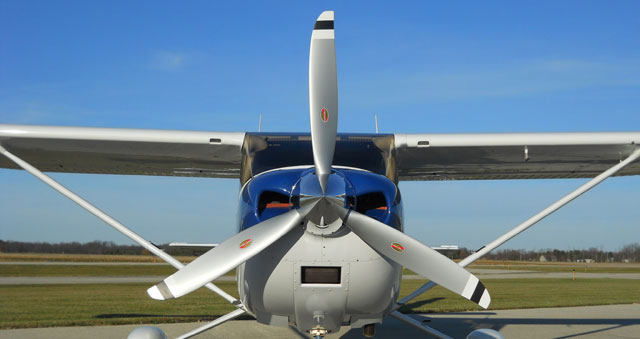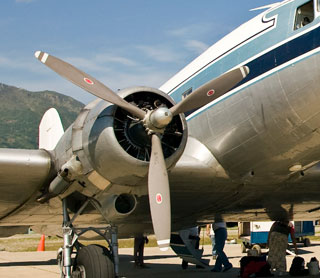
Here is a truth about my flying history. My first flight lesson never happened. The instructor, a man way too tall to fit into the ancient and glorious Cessna 152 we were about to use, walked me out to the airplane and began to talk about the preflight inspection. I checked the fuel and the oil. I checked the ailerons and flaps, the air pressure in the tires, and the amount of travel in the front strut.
When I got to the prop, I ran my hand down the length of each blade. I remember feeling the subtle twist in the shape. And I remember the way the blade curved back at the end, like a winglet.
“Wait,” my instructor said. “That’s not what it should be.”
A mechanic was called. Someone had run the end of the propeller into something. It would have to be removed and fixed. “That propeller,” he said, “would shake the engine right out of the airplane.”
“Propellers have their own story,” says Jeremy Kinney, a curator at the Smithsonian National Air and Space Museum in Washington, D.C., “and it’s just as dynamic as you can imagine.” Kinney oversees aircraft propulsion and aerial propeller development. There are 527 propellers in the museum, many of them representing new ideas in design or materials. Walk in the main entrance on Independence Avenue and one of the first things you see is the Rutan Voyager, the first airplane to circumnavigate the globe without stopping or refueling, and the Hartzell constant-speed props crucial to its long-distance performance. A prop from the Enola Gay is there. While the prop from the original Wright Flyer is in a case near the Flyer (the airplane was overturned on the ground in a gust of wind and the prop was damaged), the Spirit of St. Louis boasts its original propeller. “Lindbergh insisted on a metal propeller,” says Kinney. “His was the first well-known use of the ground-adjustable pitch idea.
“Our newest prop—the Dowty R391—is from a C–130 transport,” he says. “Six blades. Composite. Hydraulically actuated. It really is the latest, most up-to-date prop there is. But to me, the most important propellers are the Hamilton Standard props of the 1920s, ’30s, and ’40s. These became the standard, especially the Hydromatic constant-speed propeller. Every DC–3 had these Hydromatic props. Every B–17. Just about every Allied airplane had Hydromatic props. They are the basic core of what all modern propellers are.”
To be accurate, a propeller is a rotating wing in helical path. Because it’s a wing, pitch and angle of attack are the problems that keep engineers awake at night. The Wright brothers introduced the twist in the blade, but every inch of a blade should be maximally efficient. Remember calculus class? Change one variable, such as the engine or airframe behind the prop, and you have a whole new set of efficiency goals.
Sensenich makes up to 100 fixed-pitch propeller models for more than 100 different aircraft. Now in its eightieth year of business, Sensenich divides its products roughly into 50 percent aircraft, 35 percent airboat, and 15 percent UAV for the military.
“We also service the antique market,” where wooden props are made to order, says Steve Boser, a Sensenich vice president. “J–3 props are popular, as are Stearman, Fairchild, Stinson props,” he says. “There are some really obscure ones, too, like the Funk B or Bird BK. We even make the test clubs for overhaul shops, something to put a load on an engine that’s being overhauled.”
The first time enemy troops surrendered to a UAV, during the first Gulf War, the UAV was an RQ–2A Pioneer operated by the U.S. Navy. It had a 25-horsepower engine and a two-blade wooden Sensenich propeller. “It’s a continuing evolution of engineering,” Boser says. “New materials such as composites allow new shapes. New engines or airframes demand new shapes. New ways of computing data make design efficiencies easier. We’re able to push the boundaries with new materials.”

Small differences are everything in the propeller world. The difference between a climb prop and a cruise prop is only a small difference in pitch. The difference between a land and a sea prop is only pitch—and sometimes diameter, because the seaplane sits higher off the surface. But in those small differences is a universe of theory and testing and math. What engineers call the “slow down effect” describes how fuselage airflow affects prop performance. “Scrubbing drag” or “nonuniform inflow distribution” talks about how the air reaching the base of the prop is moving more slowly than the “freestream velocity” at the tip, which can have a dramatic effect on the loading.
Scott Hickman, product support manager at McCauley Propellers, says the company produces thousands of constant-speed and fixed-pitch configurations for commercial, military, UAV, and general aviation. Because McCauley’s parent company is Cessna, every propeller-driven Cessna airplane is delivered with a McCauley prop. “We’ve had significant advances in design and testing software,” he says. “It’s all about efficiency, but also about reducing noise and vibration.”
In 1941, McCauley produced the first forged ground-adjustable steel propeller, and went on to produce more than 20,000 of them during World War II. In 1970, the company introduced its first threadless blade retention system. In 2010, it introduced its first significant production of a composite fixed-pitch propeller for the Cessna 162 Skycatcher. “We’re in the certification phase of introducing a composite constant-speed prop,” Hickman says, made using the vacuum assisted resin transfer molding process. “There’s no erosion on these blades. A lot better longevity.”
In Dayton, Ohio, a man named Robert Hartzell lived down the street from a man named Orville Wright. While the first propellers on the Wright brothers’ airplanes were made by the brothers, Orville convinced Robert to take over the manufacturing in 1917. Today, Hartzell Propeller makes about 300 different blade designs that go into about 1,200 propeller models. The company only makes constant-speed props and limits its upper end to engines of less than 1,800 horsepower.
According to Mike Disbrow, senior vice president for marketing and customer services, Hartzell props have some interesting distinctions. A Hartzell prop is on the Rutan Voyager. A Hartzell prop helped set the altitude record for a piston airplane. Like everyone else, though, the engineers at Hartzell think about efficiency, noise, and weight. Their Q-tip prop, with the tips bent back, uses what amounts to an upside-down winglet at the blade end to reduce noise while keeping thrust numbers up. “We use ASC-II,” Disbrow says. “Advanced Structural Composite, version two. Carbon. Kevlar. Fully composite instead of a metal spar or wooden core. Our first composites were developed for the regional airlines—the lower weight meant greater payload. Now we’ve refined that process into a better version two.”
The scimitar prop is a new release. It really does look like a classical Middle Eastern sword blade. “There are two reasons for that shape,” says Disbrow. “The first is noise. There is some real noise reduction in that tip shape. The second is aesthetic. It’s just a really pretty propeller.”
The first passenger death in a powered aircraft was caused by propeller failure. Orville Wright was the pilot, and Lt. Thomas Selfridge was along on an inspection ride for the U.S. Army. One hundred fifty feet above the ground, the right propeller came apart, sliced a wire, and destroyed the rudder. The airplane glided to 75 feet agl, then went nose first into the ground. Wright was severely injured. Selfridge never regained consciousness and died at the hospital.
However, according to David Kenny, the Air Safety Institute’s accident statistician, fixed-wing accidents caused by structural or mechanical failures of either fixed-pitch or constant-speed propellers are rare. There were 99 during the 10 years from 2001 to 2010, inclusive, 14 of which were fatal. This represents seven-tenths of 1 percent (0.7 percent) of the 14,120 light fixed-wing GA accidents during the same period, and half of 1 percent (0.5 percent) of all fatal accidents. Half of them occurred in amateur-built aircraft.
Blade and hub failures accounted for 31 of the amateur-built accidents, one was caused by undertorqued prop bolts, and 10 were because of failures of drive belts or reduction-gear assemblies. The remaining seven were failures in pitch-change mechanisms in constant-speed props.
There are a thousand ways to imagine a propeller. Few things are more complicated; few things are more simple. It’s a rotating wing in a helical path. On the Cessna 172 I rent, it’s 42 pounds.
W. Scott Olsen is an English professor at Concordia College in Moorhead, Minnesota.


